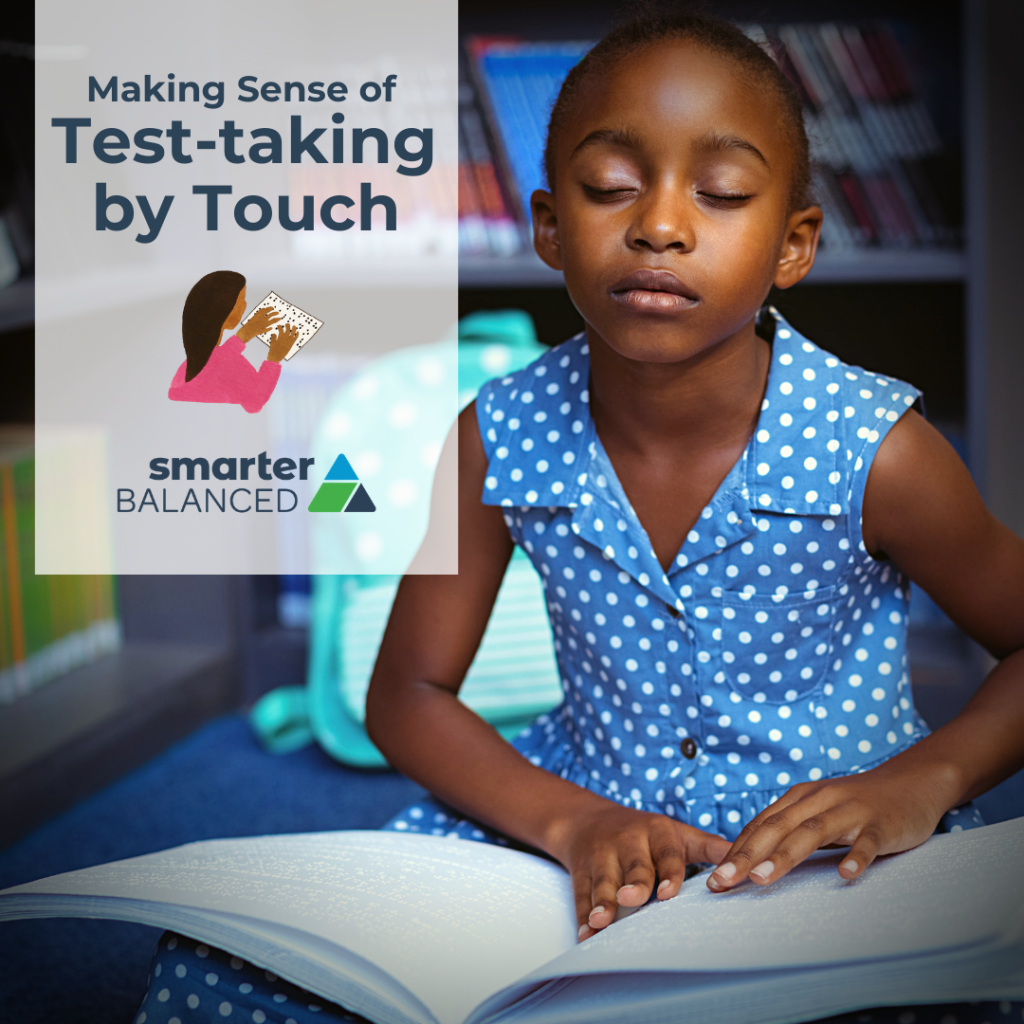Making Sense of Test-taking by Touch
Smarter Balanced Braille Accommodations Give Visually Impaired Students the Opportunity to Demonstrate What They Know and Can Do, Equitably

Braille is a nearly 200 year old, haptic (touch-based) system for reading and writing that has given millions of people with vision impairment the ability to more effectively access education and contribute to the literary canon. It’s also far from a static form of communication. We are exploring what it is, how it has changed over the years, and why it is such an important part of Smarter Balanced’s built-in test accommodations on the Summative assessment, the Interim assessments, and the Practice and Training tests (so much so that we actually have a resident braille expert on staff!).
Another big advancement was the official adoption of Unified English Braille in the US, which reached full implementation in 2016. This decision established the use of a more uniform, international form of braille. Coupled with federal guidelines that mandate children with disabilities have equal access to learning, it became increasingly important for testing platforms to give all students the opportunity to demonstrate what they know and can do, equitably. That’s where Smarter Balanced comes in. Among assessments, Smarter Balanced has the most sophisticated built-in accommodations of any assessment system, which include American Sign Language, Closed Captioning, Text-to-Speech, and of course, braille.
What are accommodations?
Accommodations are changes in procedures or materials that increase equitable access during the Smarter Balanced assessments. The accommodations described in the Smarter Balanced Usability, Accessibility, and Accommodations Guidelines (UAAG) are not modifications. Accommodations all yield valid scores that count as participation in assessments that meet the requirements of the federal Every Student Succeeds Act (ESSA), when used in a manner consistent with the UAAG.
Much of what you know about braille probably isn’t wrong—it is still a raised dot code used by people who are visually impaired to read and write using their fingertips. But, did you know that technological advancements have made it possible for braille to update in real-time? It’s true! This is called refreshable braille and it can be used on tactile devices that have thousands of tiny pins that rise and descend to produce code. New innovations promise increasingly lightweight refreshable braille devices that will make it even easier to use at work, home, or school.
Offering braille as a built-in accommodation is a complex process and starts at the very creation of a new item on the assessment. Multiple reviewers review all of the items created each year to ensure that the items will not give any particular group of students a disadvantage. Careful thought is put into the development of items, and any images that are used are checked to ensure that the items can be made into braille. From there, the items are sent to certified braille transcribers who create multiple forms of braille for each item. Did you know there are multiple forms of the braille code and even codes for mathematics? Smarter Balanced is proud to provide all of the possible braille codes for their students to ensure that individual student needs are met. These digital braille files stay with the items and are delivered directly to the student via the computer on testing day. The student can access the braille directly on the computer using a voice output program (screen reader) with a refreshable braille display which delivers braille to the student’s fingertips. If there are images within the items, the student can send those braille files directly to their braille embosser (a printer for braille) and have a paper copy of the braille on the fly! If the student prefers, Smarter Balanced offers paper braille versions of the Summative assessment as well.
“Addressing the unique and individual accessibility needs of diverse learners throughout the entire assessment system is a top priority for Smarter Balanced and the Consortium as a whole.”
Trisha Klein
According to Trisha Klein, Director of Student Supports, “Addressing the unique and individual accessibility needs of diverse learners throughout the entire assessment system is a top priority for Smarter Balanced and the Consortium as a whole.” For this reason, every year, we work to improve and grow Smarter Balanced braille accommodations, which include new development, implementation and educator supports, and innovative delivery ideas such as the Braille Hybrid Adaptive Test or the braille transcripts for students who are deafblind.
Data from the American Foundation for the Blind American Community Survey indicates that there are over half a million children under the age of 18 that have vision impairment. Of this group, 64k are legally blind. It is critical that each child receives a positive and productive assessment experience that will generate results that are a fair and accurate estimate of each student’s achievement. According to special education teachers we have talked to, it can mean more than that to visually impaired students. For some, it means the opportunity to feel more like their peers because they can participate equally.
According to Dr. Carol Scholtz, an education specialist who works with students who are blind or visually impaired in Boise, Idaho, her students said this new way of taking tests was fun. More importantly, the change in confidence Ms. Scholtz witnessed was the real measure of how braille and other accommodations impacted her students. Students oversaw using their own accessibility and accommodations resources. They could read a question using refreshable braille one line at a time, listen to the question with a screen reader that converts text to speech, and/or ask for the page to be embossed in braille so they could have an entire page of braille to read and/or understand.
Smarter Balanced is building on a framework of accessibility for all students, including English Learners (ELs), students with disabilities, and ELs with disabilities, but not limited to those groups. Braille is just one of the exciting resources provided to students to ensure students can demonstrate what they know and can do.
For more information, visit the Smarter Balanced Accessibility and Accommodations page and for an easy-to-share printable reference, download our Innovative Accessibility flier.
Meet Smarter Balanced’s Braille Expert

Trisha Klein, Director of Student Supports, supports the Consortium’s efforts in addressing the accessibility needs of diverse learners, including students with disabilities, throughout the entirety of the assessment system. Trisha provides support to work groups, advisory committees, advocacy groups, and design teams specifically around access for students who are blind or visually impaired.
Trisha comes to Smarter Balanced from the field of Visual Impairment where she served as a Teacher for the Blind and Visually Impaired and Certified Orientation and Mobility Specialist. Trisha completed her Masters level program in Vision Impairment at Portland State University and her Orientation and Mobility program at University of Northern Colorado. Her experience working with children from infancy through high school with visual impairments has given her a strong foundation in educational practices across grade levels. Trisha has also worked with bias and sensitivity reviews for assessments in multiple states and served as the point person in New England for students with visual impairments and Smarter Balanced. Trisha brings with her a passion for accessibility, assistive technology, and braille.
